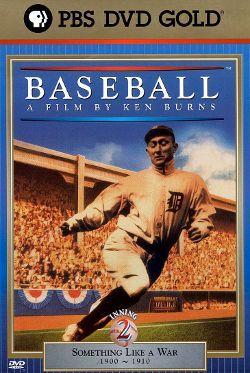Gushing with patriotism, the Second Inning of Baseball: A Film by Ken Burns begins with proclamations of the game of baseball being America’s “safety valve” and a montage of old baseball photos being scrolled to the sound of the national anthem and a spoken list of various American accomplishments during the early twentieth century.
Not all was perfect in the country, however, as Burns also points to an increase in racism across America, the growth of tenements, and a decline in baseball’s popularity. As it always does, however, baseball managed to recover. It was a time when small ball dominated the style of play, and pitchers like Christy Mathewson, “Three Finger” Brown, and Walter Johnson became legends on the mound.
Major league baseball entered the twentieth century in trouble, beset by declining attendance, rowdyism, unhappy players, and feuding, greedy club owners, but then divided itself in two, cleaned itself up, and succeeded beyond anyone’s wildest dreams. The World Series began, and season after season more than five million fans filled stadiums to see their heroes play, and countless millions more, who had never been lucky enough to watch them in person, followed their every move in the sports pages.
In part two of this documentary series, we see the rise of players like Honus Wagner and Ty Cobb, two of the most diametrically different players as the game has ever seen. We meet player-manager John McGraw, who approached the game with a furious kind of passion recognized throughout baseball. The “Christian Gentleman,” Christy Mathewson, also appeared on the scene playing for McGraw, and his precise pitching captured the attention of teams and fans across America. Together, Mathewson and McGraw’s Giants dominated the sport.
 We also see the rise of Ban Johnson and the American League. The National Agreement brought peace between the new AL and the older National League, though the reserve clause remained intact, leaving ballplayers themselves with no voice in the administrative side of the game. And to no one’s surprise, I’m sure, overpriced concessions have been a staple of ballparks since the game became a business. This time period saw the introduction of hot dogs, served to fans in buns to allow them to hold them while watching baseball.
We also see the rise of Ban Johnson and the American League. The National Agreement brought peace between the new AL and the older National League, though the reserve clause remained intact, leaving ballplayers themselves with no voice in the administrative side of the game. And to no one’s surprise, I’m sure, overpriced concessions have been a staple of ballparks since the game became a business. This time period saw the introduction of hot dogs, served to fans in buns to allow them to hold them while watching baseball.
Once again, we see descriptions of racism in baseball followed closely by an update on the life of Branch Rickey. Burns hints at the impact of seeing discrimination on Rickey’s views. Later in this disc, there is a more in-depth discussion of black baseball, including the creation of the Negro Leagues led by Rube Foster. The documentary also introduces (though it really doesn’t dive much into) the concept of “bloomer girls,” women playing baseball during this time period.
Some of the most recognizable pieces in baseball pop culture also came into existence in the late-nineteenth and early-twentieth centuries. Franklin Pierce Adams’s poem, “Baseball’s Sad Lexicon,” also known as “Tinker to Evers to Chance,” was written in 1910, Ernest Thayer’s iconic poem “Casey At the Bat” (1888) was recited frequently by performers, and Jack Norworth’s “Take Me Out to the Ballgame” became the game’s anthem.
The Second Inning ends at the conclusion of the 1909 season, following a discussion of Fred Merkle’s 1908 boner and a more direct rivalry between Ty Cobb and Honus Wagner in the 1909 World Series. It’s hard to tell if Burns is particularly fascinated by Cobb, or if there are just too many good stories there to ignore, but Cobb does garner a fair amount of attention in this inning. Not that I’m complaining — I wouldn’t have wanted to play against him (and probably not even with him), but Cobb does add some color to the game’s history.




